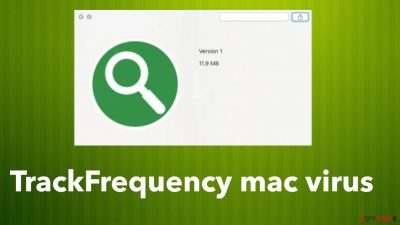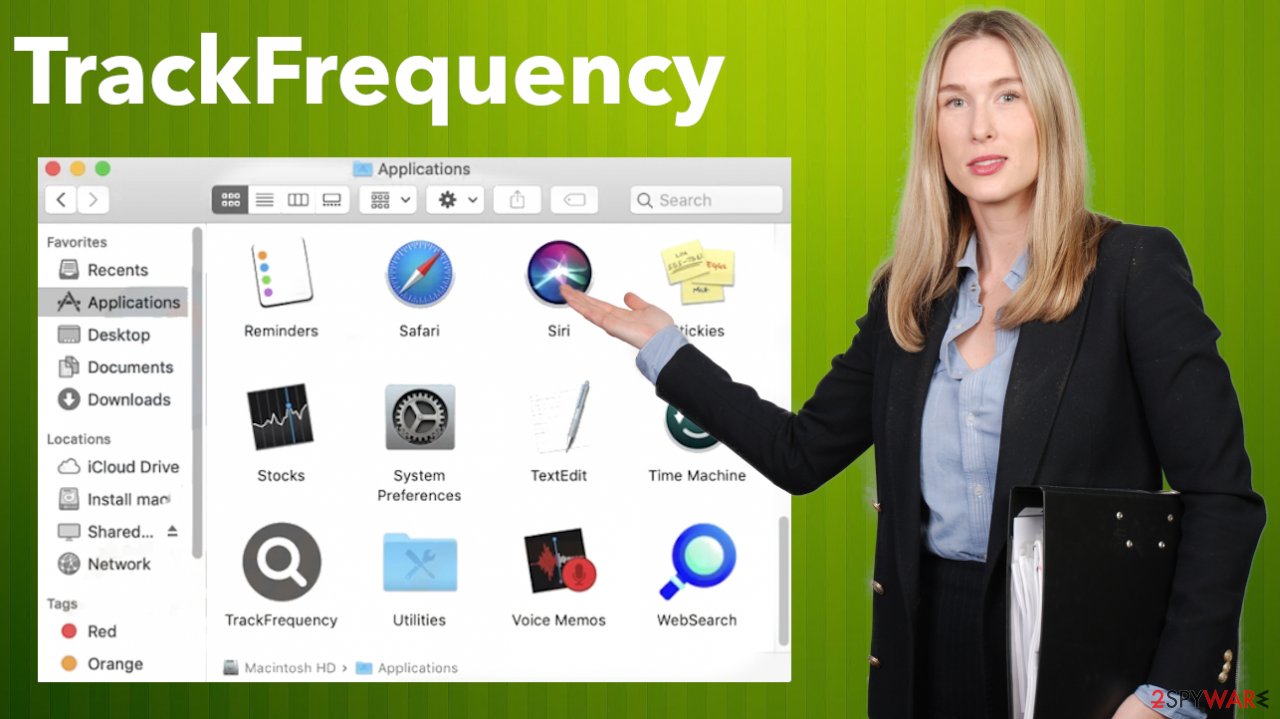TrackFrequency mac virus (spam) - guide
TrackFrequency mac virus Removal Guide
What is TrackFrequency mac virus?
TrackFrequency mac adware is a useless app that injects advertisements into pages you often visit

TrackFrequency is the adware or a mac virus that causes changes to web browser settings and preferences to control the online traffic and expose users to particular advertising material provided by the sponsors. This potentially unwanted program is never a good sign because all these pop-ups, banners, and other material that appears due to the background process can cause security and privacy issues.
These intrusive programs can come pre-bundled[1] with other freeware apps, so these programs appear out of nowhere after the insecure installation or download of the particular tool. These apps like the particular TrackFrequency mac adware, can cause the installation of additional apps or browser-based tools. It is advised to get rid of the PUP as soon as possible.
| Name | TrackFrequency |
|---|---|
| Type | Adware, mac virus |
| Category | Potentially unwanted application |
| Family | Adload |
| Issues | The program causes advertisements to appear where they should not. It affects the online traffic with redirects and constant pop-up ads |
| Distribution | Freeware installations, torrent sites, other deceptive pages, other programs, random banners, ads |
| Damage | The program is running in the background with questionable purposes and goals. The app can lead to infiltration of other cyber threats |
| Elimination | Threats from macOS devices can be removed with anti-malware tools and security software compatible with the device |
| Repair | These intruders can trigger issues with the system. Repair virus damage and get rid of the leftovers with FortectIntego |
Can Mac get infected?
There are many speculations that these threats affecting macOS-based devices are not real and that all Apple products like iPhones are immune to cyber threats. The family this TrackFrequency mac virus comes from shows the opposite because these Adload adware-type intruders are primarily developed for this purpose – infecting Macs.
You cannot find this particular adware on the machine that runs Windows operating system, but there are similar potentially unwanted programs[2] that spread and affect the performance. These unwanted applications can cause more than the diminished performance or affect the experience online.
TrackFrequency mac adware is the variant of the same threat that appears out of nowhere and shows various advertisements, causing redirects to possibly dangerous platforms and websites. This is the worst thing about these browser-based applications. All of them are related to ad-supported pages and promote questionable software or tools further.
Stopping the PUP properly
This program appears installed in the Application folder, but you cannot take the TrackFrequency app to the trash and call it a day. These procedures and programs that affect the time on the internet are running in the background because the main PUP is not the app that shows up.
You need to remove the adware properly and take care of the affected parts. Experts[3] recommend keeping anti-malware tools on the machine to avoid infiltrations like this. So, in this case, the AV detection engine can be the one that helps to remove the TrackFrequency mac virus properly.
The anti-malware or security applications compatible with the macOS can check the machine for any hidden files, and if the engine is powerful enough, the program like SpyHunter 5Combo Cleaner or Malwarebytes can indicate the infection and properly remove it from the computer without additional damage.

Manually clearing the system
You might still experience some of the issues with the machine when the altered settings on the machine cause those problems. You might want to find all the related issues and installed apps yourself, so the TrackFrequency mac virus is stopped. This might take time and require some knowledge.
Remove items from Applications folder:
- From the menu bar, select Go > Applications.
- In the Applications folder, look for all related entries.
- Click on the app and drag it to Trash (or right-click and pick Move to Trash)
![Uninstall from Mac 1 Uninstall from Mac 1]()
To fully remove an unwanted app, you need to access Application Support, LaunchAgents, and LaunchDaemons folders and delete relevant files:
- Select Go > Go to Folder.
- Enter /Library/Application Support and click Go or press Enter.
- In the Application Support folder, look for any dubious entries and then delete them.
- Now enter /Library/LaunchAgents and /Library/LaunchDaemons folders the same way and terminate all the related .plist files.
![Uninstall from Mac 2 Uninstall from Mac 2]()
TrackFrequency mac virus can affect the settings and preferences of web browsing tools. If so, you might want to clear the installations and added applications there. The full reset of Google Chrome or Safari can be too much and interfere with your work, so try to follow the separate guides below and remove unwanted applications manually.
You should already understand that these macOS devices that are advertised as immune to threats are capable of catching threats. These TrackFrequency ads and redirects can confirm. So make sure to create additional habits that help to keep the machine virus-free.
That, of course, is closely related to the content you visit while browsing the internet. You can track these advertising-based intruders when you constantly click on shady ads and redirect from other pages. It is possible to catch the PUP and then allow the malicious program on the machine without realizing it. Avoid torrents and promotional ads, and you might avoid these issues with other threats like the TrackFrequency virus.
You may remove virus damage with a help of FortectIntego. SpyHunter 5Combo Cleaner and Malwarebytes are recommended to detect potentially unwanted programs and viruses with all their files and registry entries that are related to them.
Getting rid of TrackFrequency mac virus. Follow these steps
Remove from Mozilla Firefox (FF)
Remove dangerous extensions:
- Open Mozilla Firefox browser and click on the Menu (three horizontal lines at the top-right of the window).
- Select Add-ons.
- In here, select unwanted plugin and click Remove.

Reset the homepage:
- Click three horizontal lines at the top right corner to open the menu.
- Choose Options.
- Under Home options, enter your preferred site that will open every time you newly open the Mozilla Firefox.
Clear cookies and site data:
- Click Menu and pick Settings.
- Go to Privacy & Security section.
- Scroll down to locate Cookies and Site Data.
- Click on Clear Data…
- Select Cookies and Site Data, as well as Cached Web Content and press Clear.

Reset Mozilla Firefox
If clearing the browser as explained above did not help, reset Mozilla Firefox:
- Open Mozilla Firefox browser and click the Menu.
- Go to Help and then choose Troubleshooting Information.

- Under Give Firefox a tune up section, click on Refresh Firefox…
- Once the pop-up shows up, confirm the action by pressing on Refresh Firefox.

Remove from Google Chrome
Delete malicious extensions from Google Chrome:
- Open Google Chrome, click on the Menu (three vertical dots at the top-right corner) and select More tools > Extensions.
- In the newly opened window, you will see all the installed extensions. Uninstall all the suspicious plugins that might be related to the unwanted program by clicking Remove.

Clear cache and web data from Chrome:
- Click on Menu and pick Settings.
- Under Privacy and security, select Clear browsing data.
- Select Browsing history, Cookies and other site data, as well as Cached images and files.
- Click Clear data.

Change your homepage:
- Click menu and choose Settings.
- Look for a suspicious site in the On startup section.
- Click on Open a specific or set of pages and click on three dots to find the Remove option.
Reset Google Chrome:
If the previous methods did not help you, reset Google Chrome to eliminate all the unwanted components:
- Click on Menu and select Settings.
- In the Settings, scroll down and click Advanced.
- Scroll down and locate Reset and clean up section.
- Now click Restore settings to their original defaults.
- Confirm with Reset settings.

Delete from Safari
Remove unwanted extensions from Safari:
- Click Safari > Preferences…
- In the new window, pick Extensions.
- Select the unwanted extension and select Uninstall.

Clear cookies and other website data from Safari:
- Click Safari > Clear History…
- From the drop-down menu under Clear, pick all history.
- Confirm with Clear History.

Reset Safari if the above-mentioned steps did not help you:
- Click Safari > Preferences…
- Go to Advanced tab.
- Tick the Show Develop menu in menu bar.
- From the menu bar, click Develop, and then select Empty Caches.

After uninstalling this potentially unwanted program (PUP) and fixing each of your web browsers, we recommend you to scan your PC system with a reputable anti-spyware. This will help you to get rid of TrackFrequency mac registry traces and will also identify related parasites or possible malware infections on your computer. For that you can use our top-rated malware remover: FortectIntego, SpyHunter 5Combo Cleaner or Malwarebytes.
How to prevent from getting adware
Choose a proper web browser and improve your safety with a VPN tool
Online spying has got momentum in recent years and people are getting more and more interested in how to protect their privacy online. One of the basic means to add a layer of security – choose the most private and secure web browser. Although web browsers can't grant full privacy protection and security, some of them are much better at sandboxing, HTTPS upgrading, active content blocking, tracking blocking, phishing protection, and similar privacy-oriented features. However, if you want true anonymity, we suggest you employ a powerful Private Internet Access VPN – it can encrypt all the traffic that comes and goes out of your computer, preventing tracking completely.
Lost your files? Use data recovery software
While some files located on any computer are replaceable or useless, others can be extremely valuable. Family photos, work documents, school projects – these are types of files that we don't want to lose. Unfortunately, there are many ways how unexpected data loss can occur: power cuts, Blue Screen of Death errors, hardware failures, crypto-malware attack, or even accidental deletion.
To ensure that all the files remain intact, you should prepare regular data backups. You can choose cloud-based or physical copies you could restore from later in case of a disaster. If your backups were lost as well or you never bothered to prepare any, Data Recovery Pro can be your only hope to retrieve your invaluable files.
- ^ Lowel Heddings. Yes, Every Freeware Download Site is Serving Crapware. Howtogeek. IT and cybersecurity advice.
- ^ Potentially unwanted programs. Wikipedia. The free encyclopedia.
- ^ Senzavirus. Senzavirus. Spyware related news.












